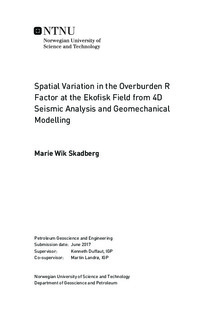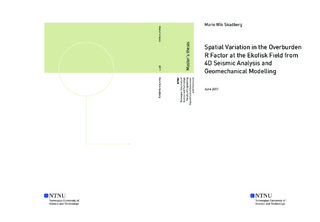| dc.description.abstract | 4D seismic analysis of the overburden is essential in well planning and risk analysis. The
dilation factor (R) links the changes in velocities and thicknesses causing time shifts. The focus of this thesis has been determination of both vertical and lateral variation in the overburden R factor across the Ekofisk Field in the North Sea. The R factor has been studied above depleting and repressurized regions using 4D seismic data from 2011 to 2014 and 1D geomechanical modelling.
Superposition of Geertsma s nucleus of strain model proved to simulate the displacement
changes in the overburden of depleted regions, but not repressurized regions. Synthetic time
shifts were generated from the geomechanical model and further compared with observed time shifts to establish the depth-dependent R factor. This revealed a strong vertical variation in the R factor in the depleting zone, with values decreasing with depth from about R = 14 in the shallow overburden (750m) towards R=2 at the top reservoir (3000m). The depth-dependency of R appears robust from evaluation of alternative models for overburden strain.
In addition to the vertical change in the R factor, a clear lateral variation was observed. A
constant R factor in the vertical direction was assumed, and the focus was on the contrasts in R between depleted and repressurized regions. Two approaches estimated the R factor based on 4D; one using only the time shifts at top reservoir, the other using the depth-dependent time shift. The total overburden thickness change was implemented to confirm the results from both methods. This was estimated from reservoir compaction and sea floor subsidence from bathymetry data. The results from the approaches were consistent; R was larger in the overburden above the injection zones, where R was 4 to 8, while between 2-3 in the depletion zone. The magnitude of R in the injection zones corresponded to the level of repressurization. The lateral variation is believed to be caused by localized reservoir compaction at the Ekofisk Field, which is triggered by production-induced activity across the field.
Production-induced changes in velocities and vertical thicknesses were calculated from 4D
time shifts using both constant and depth-dependent R factor. The estimation of thickness
change was very sensitive to which R factor was applied, but it was insignificant when estimating velocity change. | |

